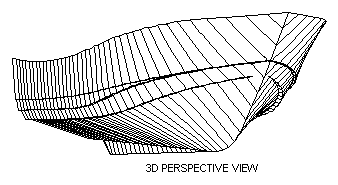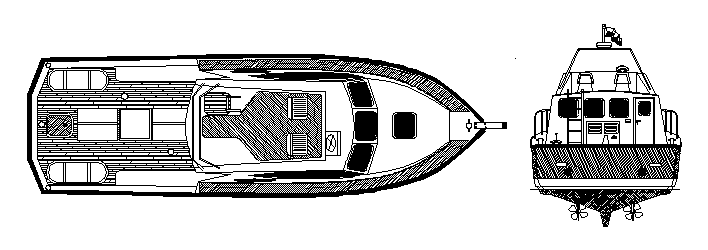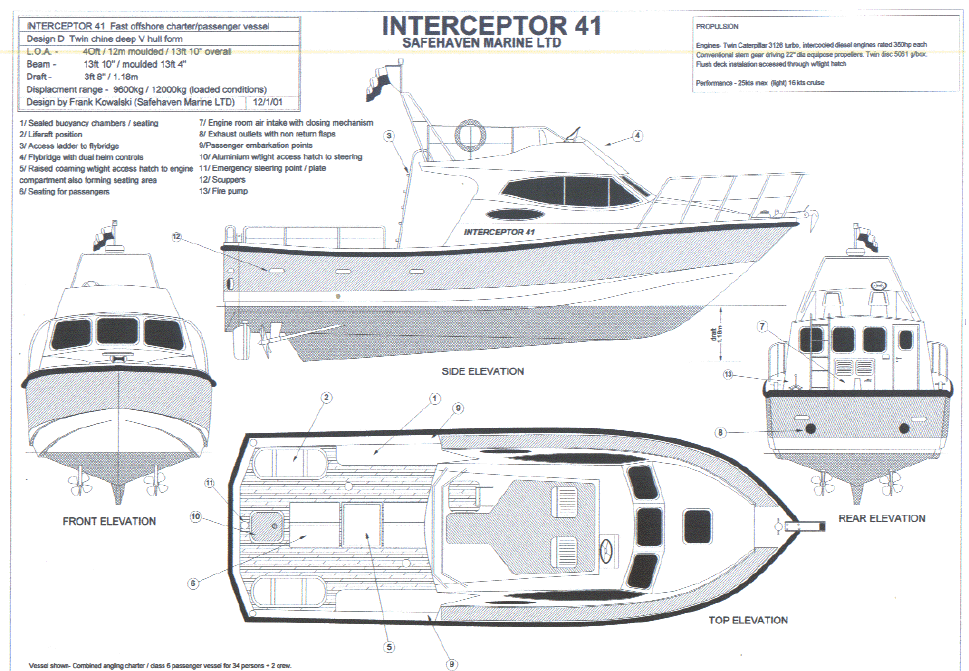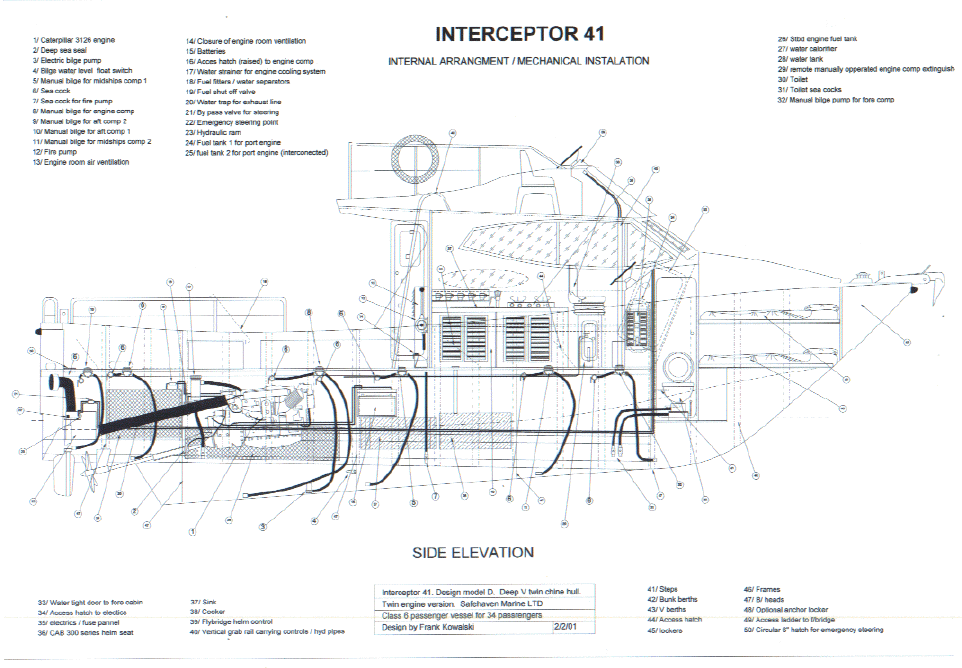
NEW INTERCEPTOR 42
We are currently expanding our existing model range
of 33 and 38ft fast offshore craft with a new 41 ft vessel. Called the
Interceptor 41, this vessel has been designed to be our new flagship, with a
length overall of 42ft, and a beam of 13ft 10” she will meet the demands of
owners requiring the maximum deck area and stability.
In
designing the new vessel the following criteria were considered the main
requirements:
1/
Sea keeping. With the main emphasis on overall rough weather
capabilities. In order of importance these capabilities were:
·
Course keeping and dynamic stability in following seas.
·
Static stability when stationary in rough conditions.
·
Attitude of vessel to wind when static and speed of drift.
·
Adequate head sea abilities set as the ability to maintain 15 kts into a
head sea generated by a force 5-6 open sea wind.
·
High freeboard to prevent green water been shipped on deck or over the
bow.
2/
Performance. The hull to be easily driven and economical.
3/
Large load carrying capabilities with impressive GZ curve and GM figures.
Hull
form development.
In
order to meet the above requirements careful consideration was made to the hull
form chosen. A deep V, hard chine hull form was considered to most easily meet
these requirements. Used in our other vessels the deep V hull form is generally
accepted as having superior seakeeping abilities to other designs most notably
in course keeping abilities in large following seas. A point of interest is that
in designing the R.N.L.I.’s new fleet of
‘fast afloat boats’ the Severn and Trent class, a comparison test of
the seakeeping of traditional round bilge craft and Deep V hulls was made in
order to determine which hull form would eventually be used in the new class of
Lifeboat. These tests indicated that whilst vertical acceleration motions
measured at the bow at speed in head seas were similar on both types the deep V
hull showed a dramatic advantage in been able to maintain a course in following
seas with much less recourse to the helm, heel and yaw were also much less in
the Deep V hull as were rolling in static tests.
Bearing in mind the intended operational envelope of the craft which is
to be able to run at a speed of 15kts regardless of direction in a sea state
generated by a force 5-6 open water wind, with the potential ability to run at
greater speeds in beam, quartering and following seas, the hulls deadrise angles
were set at 22 degrees amidships, 17 at the transom and a fine waterline entry
of 49 degrees. The relatively fine waterline entry is achieved through a high
main chine at the bow which will reduce the likelihood of slamming occurring in
head seas.

To
provide good course keeping abilities the vessels beam to length ration was optimized
with a beam overall of 13ft 10” giving a high GM, which will reduce
heel and subsequent yaw in large quartering seas.
A full length keel was considered for amongst other
reasons good directional stability at slower speeds.
Hard chines and spray rails with a 10 degree down
angle fwd are used to provide lift to the hull, stability, and aid in spray
deflection as well as general boat dryness. To further aid stability, the
secondary spray defection rail used successfully on the existing 38 has been
modified to become a second chine, which is designed to run dry at speed but
become immersed at rest when heavily loaded aiding in stability. As a secondary
feature general seakeeping and boat dryness is improved, as any spray running
past the main chine is deflected by the second chine, the second chine also
helps to provide additional lift and resistance to rolling at large angles of
heel encountered in heavy seas.
Special consideration was given to the vessels bow.
In order to prevent the likelihood of green water been shipped over the bow
adequate sheer was provided with plenty of flare and reserve buoyancy above the
chine. Furthermore to prevent any likely hood of broaching in large following
seas the hull has a cutaway forefoot and well raked stem, designed to prevent
the bow burying deeply into the back of waves, and acting as a fulcrum causing
the stern to swing round in a classic broaching action.
As commercial charter and static gear work is
envisaged as a part of the vessels intended use special attention was paid to
the vessels likely attitude of drift to the wind, speed of drift and stability
whilst static. To this end a full length keel is used providing good grip and
roll dampening . Also as it is envisaged that most owners will require a large
single engine configuration the keel has sufficient depth to allow propeller
sizes of up to 28” (5-600hp) to run in a specially developed, large propeller
tunnel, fully protected by the keel. To this end the likelihood of damage and
fouling of the propeller is reduced and allows the vessel to beach safely.

Extensive computer resistance and propulsion analysis
has been carried out to optimize the hulls performance. Deadrise angles beyond
the slamming area are reduced to increase lift. The angle of rise in the hulls
run is reduced to 1 degree to optimize trim angles. The hulls bottom has near
parallel buttock lines in the aft sections, and warp in the bottom kept to a
minimum. A slight degree of convexity is present in the very f/wd sections to
soften motions. Maximum WL beam is at midships in order to provide a LCB of 58%,
needed in order to provide level longditudal static trim with the relatively
f/wd LCG of this type of craft.
As the first of class is to be a class 6 passenger vessel, the
hull has to provide an exceptionally high degree of stability,
especially in passenger crowding heel angles and maximum GZ. The hulls ample
beam will provide a safe, stable platform in this respect.
Finally, the overall looks of the vessel have not
been overlooked. The same attractive, graceful sheer line, styling knuckle and
two tone colour scheme (a main dark colour above the knuckle and white below) as
used on our 38 is retained.
Superstructure.
A sleek, modern superstructure has been designed,
very similar to that used in our existing 38. Similar window styling is retained
as this has proved very popular and has become a distinctive feature of our
Interceptor range. An optional flybridge moulding is to be available which will
extend some way over the aft cockpit to provide shelter for passengers. The
mould for the superstructure will be able to be altered to provide either short
wheelhouse versions for commercial vessels. Std wheelhouse length used for
charter work to extended versions for recreational and cruising vessels.
The first vessel ordered is to be a class 6 passenger
vessel for 34 passengers operating on the west coast of Ireland. Conforming to
the very strict intact and damage regulations that apply to passenger vessels.
Her general arrangement can bee seen below. Fitted with a st/d length
superstructure to provide comfortable accommodation and seating inside for 8
persons. A full galley and separate heads compartment are provided. Powered by
twin Caterpillar 3126 engines at 300hp each. On a light ship displacement of
10,000kg she is expected to have a maximum speed of 25kts and cruise speed of
18-20kts.
The commercial short wheelhouse version being
developed simultaneously will provide a 26 sq m flush aft cockpit whilst still
retain comfortable accommodation for the crew. The commercial version will use
as st/d Caterpillars 3208 10.4 litre V8 rated at 375hp, which will give a
sustainable, loaded, economical cruise of 16kts.
Recreational versions will have increased
accommodation yet still retain a good sized aft cockpit.
Propulsion.
As standard the vessel is fitted with a single
Caterpillar 3208 10.4 litre V8 rated at 375hp/450hp. Running conventional stern
gear through a twin disc gearbox, 1 ¾ T/met shaft and 25” dia 4 blade
propeller. On an anticipated lightship displacement of approx 9,000kg she will
have a maximum speed of 21/ 23kts and a cruising speed of 16/ 18kts.
As an option Caterpillars 3196 electronic 12 litre
straight 6 rated at 570hp will provide a maximum speed of 26kts and a cruise
speed of 21kts. For twin engine installations, two Caterpillar 3126 8 litre
straight 6 engines are used at 300-420hp (600-840hp total) which will provide a
maximum speed of 25-30kts and a
cruise of 20-24kts. Flush deck installations are available on twin and single
engine craft.
Construction
Shell laminate and scantlings on commercial craft have been determined in
general from Lloyds special service craft rules and regulations.
GRP
composite construction using CSM.
Woven rovings and uni-directional fibres. (All materials Lloyds approved)
Hull
main shell laminates: Bottom- 6800gm2. Sides- 3900gm2. Keel 8400gm2. Chine-
8400gm2.
Scantlings:
Transverse frames @ .600mm centres. 2x 200x50mm main longditudals. 2x secondary
longditudals. Additional panel breakers positioned to provide a max unsupported
panel width of 280mm over the
bottom structure.
The
above scantling and hull thickness will provide a very strong, durable structure
capable of operating safely in rough offshore conditions.
As we progress with the development of the Interceptor 41 we will keep adding information and pictures to keep you informed, so watch this space!!!
The final drawings for the first boat have been completed, shown below:

